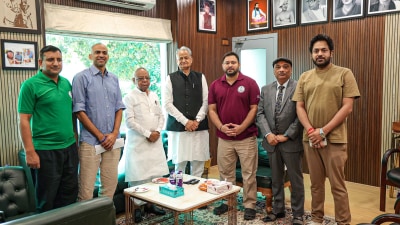Gujarat faces `parched’ summer
AHMEDABAD, APRIL 28: If it's summer, can water problems be far behind? And so it is this year, too, and it may be more serious than we'd ...

AHMEDABAD, APRIL 28: If it’s summer, can water problems be far behind? And so it is this year, too, and it may be more serious than we’d care to think: A severe crisis is in the making in as many as 31 talukas of Gujarat because of over-exploitation of groundwater.
These are the findings of a state government report, published recently, which suggests that more water is being pumped out than is being recharged every year.
The study has divided the 183 talukas in four categories: over-exploited, dark, gray and white zones, depending on the extent of exploitation of groundwater.
The over-exploited talukas are spread over Ahmedabad, Amreli, Banaskantha, Bharuch, Gandhinagar, Junagadh, Kheda, Kutch, Sabarkantha and Mehsana districts. In all of them, water is disappearing not only in the `dynamic zone’, which is recharged regularly, but also in the deeper `static zone’, which does not get recharged.
Experts say water should be drawn only from the `dynamic zone’; the `static zone’, where water hasaccumulated over thousands of years, should remain untouched. As one expert said, “It should be left for posterity”.
Eight talukas fall in the dark zone, which comprises areas where the rate of exploitation of groundwater is between 90 and 100 per cent.
As many as 42 talukas fall in the gray zone, where exploitation of groundwater ranges between 70 and 90 per cent, while the remaining 102 talukas constitute the white zone, where up to 70 per cent of the groundwater has been exploited.
Concerned over the situation, the Central Ground Water Authority is actively considering notifying as “critical” some of the over-exploited areas of north Gujarat.
Experts attribute the problem to the absence of any check on indiscriminate use of groundwater by farmers for irrigation purpose. The Bombay Irrigation Act had been passed in 1976 to regulate exploitation of groundwater but, say experts, successive state governments have fought shy of enforcing it for the fear of offending the powerful farmers’lobby.
“What gave a free rein to farmers”, says a top official at the Gujarat Water Supply and Sewerage Board, “was the Chimanbhai Patel goverment’s populist decision to charge farmers a flat, concessional rate for their electricity consumption”. So they used electricity liberally, depleting groundwater at a faster rate.
The act — which incidentally covers eight of the districts having over-exploited talukas — prohibits digging of borewells beyond the depth of 140 feet, but recent reports say there are borewells more than 340 feet deep.
HIT LIST
Talukas where usable ground water has been depleted
Ahmedabad district: City and Daskroi, Dholka, Dehgam, Sanand
Amreli district: Kodinar. Banaskantha district: Tharad, Vagam, Deodar
Bharuch district: Amod, Jambusar
Gandhinagar district: Gandhinagar
Junagadh district: Porbandar, Vanthali, Manavadar, Mangrol
Kheda district: Kapadvanj, Balasinor
Kutch district:Bhachan, Anjar
Sabarkantha district: Meghraj, Idar
Mehsana district: Kadi, Kalol, Kheralu, Visnagar, Vijapur, Sidhpur, Patan
Mehsana, Chanasma and Harij have been classified as “salinity talukas” where development of groundwater is not feasible.





- 01
- 02
- 03
- 04
- 05


























